
Coleus: sowing, planting and care
Contents
Coleus in a nutshell
- Coleus is distinguished by slightly velvety, remarkably decorative foliage
- It declinates into a large number of varieties and cultivars, offering an incredible palette of bold or subtle colours, solid or variegated
- It is a frost-tender perennial, grown as an annual in garden or as an indoor plant
- Very easy to grow in light, rich, cool soil, in sun or partial shade
- Adds a colourful, graphic touch to flower bed borders, pots and planters
A word from our expert
Coleus, sometimes called “Coliole” or “Gypsy plant” is one of the best annuals for colourful foliage! Blue coleus, pink coleus or coleus with pink and green leaves (coleus ‘Kong’, ‘Rainbow’ or ‘Arc-en-ciel’), they will continue to surprise you, from early summer until the frosts.
Alongside coleus forskohlii or barbatus, widely used in Ayurvedic medicine for its medicinal properties, our nurseries mainly grow Solenostemon scutellarioides (syn. Coleus blumei), a species that has given rise to numerous varieties offering an unlimited choice of colours: plain or variegated, bicoloured or tricoloured, ranging from anise green to yellow, through rust to almost black-purple.
Tender, coleus can also be grown as an indoor plant.
From sowing coleus seeds to planting our coleus plug plants, learn all about this easy-to-grow annual.
Equally at ease in pots or in open ground, indoors or outdoors, discover coleus, this versatile annual plant capable of creating beautiful displays throughout the season, without relying on flowering!
Description and botany
Botanical data
- Latin name Coleus
- Family Lamiaceae
- Common name Coleus, Coliole, Gitane
- Flowering July to October
- Height 0.30 to 0.60 m
- Sun exposure Sun, partial shade
- Soil type light, rich, fresh but well-drained
- Hardiness frost-tender
The Coleus or coliole is a herbaceous perennial native to tropical forests of Africa, the Americas and Southeast Asia, belonging to family Lamiaceae along with nettle, sage and lavender.
Perennial in its native habitat, it is grown as an annual in our gardens or as a houseplant because of its low hardiness as it does not tolerate temperatures below 5 °C.
The genus Solenostemon, formerly Coleus, comprises more than 150 species, cultivars and hybrids with very varied shapes and colours offering an impressive choice!
Hybrid coleus and the cultivars most often offered in garden centres are mainly derived from species Solenostemon scutellarioides (syn. Coleus blumei) and are characterised by particularly decorative foliage. They are often released in series grouping varieties of different colours.
Fast-growing, Coleus develops attractive bushy clumps, erect, with a pyramidal habit and ramified branches that reach 30 to 50 cm in height and almost as wide depending on variety.
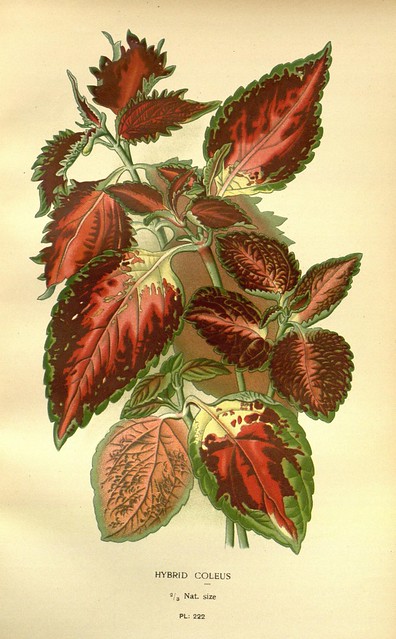
Coleus – botanical illustration
Coleus is one of those plants remarkable for the sumptuous colours of its foliage. On quadrangular, fleshy and brittle stems unfold deciduous, opposite leaves, ovate or heart-shaped, slightly dentate or deeply divided. They are sometimes so veined and undulate that they appear embossed. Villous beneath and slightly velvety above, they measure 2 to 15 cm long and in appearance resemble leaves of nettle or mint. Depending on variety, they may be triangular, lobed, fringed or even ruffled.
The elegant foliage of coleus never goes unnoticed. Ranging from striking and baroque to more discreet, the leaves display solid, variegated, bicolour or tricolour colourings, sometimes surprising, eccentric to the point of garishness or rare in the plant world. The palette of tones is endless, from absinthe-green to zesty yellow, from rust to purplish-red almost black (Coleus Palisandra or “Painted Nettle”) through Indian pink or cream-white.
With their large soft leaves, variegated, marginate or splashed with lighter or darker tones combining several colours, some cultivars look as if painted, showing often explosive contrasts (Coleus ‘Wizard Mixed’, Coleus hybrid ‘Rainbow’).
Coleus is valued for its foliage rather than its flowering. On this colourful vegetation, small bilabiate inflorescences gathered in little clusters appear from June to October at the stem tips. Pink, mauve, blue or white, they are of little interest and are best removed to preserve vigorous foliage.
Coleus is a frost-tender perennial that fears frost, rarely tolerating temperatures below 5 °C, which is why it is grown as an annual to resow or replant each spring in the garden, in window boxes or containers. Coleus is also an excellent houseplant that can be kept indoors year-round.
Very easy to grow, it prefers a sunny but non-scorching exposure or partial shade to preserve its bright colours and a rich, light, deep, fresh but well-drained soil.
Coleus is a valuable annual to bring contrast, colour and brightness to natural or wild-style gardens, unpretentious, for composing colourful scenes. Plant it as an edging, along a path, in borders and beds, in rockeries that are not too dry or in pots and planters.
Variations in leaf colouring of some coleus are due to a lack of chlorophyll between different zones.
The coleus canina, nicknamed “cat terror” belongs to a different genus (Plectranthus) and should not be confused with ornamental coleus: its foliage, with an unpleasant odour, acts as a repellent to dogs and cats.
Main species and varieties
Coleus, derived mainly from species Solenostemon scutellarioides (syn. Coleus blumei), are available as series sold as seeds such as the Wizard® series which includes hybrids in various colours, or as cultivars offered as plug plants such as Coleus ‘Black Prince’.
Most popular
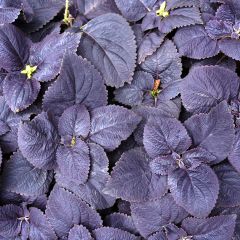
Coleus blumei Palisandra Seeds - Solenostemon scutellaroides
- Height at maturity 60 cm
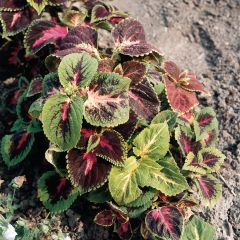
Coleus Rainbow Mix Seeds
- Flowering time July to November
- Height at maturity 50 cm
Our favourites

Solenostemon Wizard Mixed
- Height at maturity 50 cm
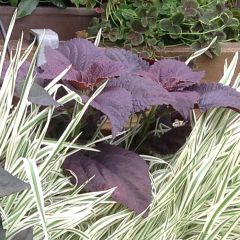
Coleus Black Prince
- Flowering time June to November
- Height at maturity 80 cm
Discover other Coleus seeds
View all →Available in 1 sizes
Available in 1 sizes
Available in 1 sizes
Available in 1 sizes
Available in 1 sizes
Available in 1 sizes
Available in 1 sizes
Available in 1 sizes
When and how to sow coleus seeds?
Sow coleus seed from January to March under cover at a temperature of 20 to 25 °C.
Here is how to proceed:
- On surface of a good potting soil enriched with well-rotted compost, sow coleus seed thinly
- Do not cover seeds, they need light to germinate
- Water with a fine spray and keep moist until germination: germination will take 10 to 20 days
- Keep warm, prick out young plants into individual buckets as soon as they are sturdy enough to handle
- When young plants reach about 15 cm, pinch out the tip to encourage them to become ramified
- Acclimatise your plants gradually to outdoors but only place outside at end of May/early June when temperature has warmed
Find our advice for successful sowing of annual seeds!
Planting coleus
Where to plant Coleus?
Frost-tender, Coleus cannot withstand temperatures below -5 °C. It withers at first cold! Consequently it is grown as an annual in open ground in the garden or in pots on the terrace or balcony. Bring pots indoors at first frosts into a cool conservatory to keep them. It can also be grown as an indoor plant to keep year-round in a bright room out of direct sun; it will then behave as a perennial and can be kept for several years.
Coleus likes well-drained soils that remain cool in summer, rich and fertile, even slightly acidic. It appreciates sunny positions where its colours will be enhanced, but prefers partial shade to scorching sun, which will preserve the colouring of its foliage, especially in southern France.
Versatile, it is indispensable for dressing shaded areas, flowering a path border, the foreground of a flowerbed, a rockery that is not too dry, and for edging a summer flower bed with elegance and colour. It creates bold, eye-catching or more discreet coloured clumps, in all naturalistic or romantic gardens. Coleus is also the ideal annual plant for pots and window boxes and a good conservatory plant.
When to plant Coleus?
Planting Coleus is carried out in spring, from March to June depending on region, in all cases after last frosts when temperatures begin to warm.
How to plant Coleus?
In open ground
Set out in May–June, when soil has warmed, spacing the plug plants of Coleus 25 to 30 cm apart and allow 4 to 5 plants per m2 for a splendid shimmering mass effect.
- Dig a hole 2 to 3 times larger than the plug plant
- Add gravel or clay pebbles to the bottom of the hole
- Add a good spadeful of compost to each planting hole
- Place the plug plant in the centre of the hole, and plant without burying the collar
- Backfill and firm down
- Water
Make the most of our advice to successfully plant annual flowers from plug plants
In pots
Plant only one Coleus per 15 cm diameter pot. In mixed containers or a window box, space plants 15 to 20 cm apart. All tips for planting window boxes and hanging baskets with annuals in plug plants are on our blog!
- Line bottom of container with gravel or clay pebbles
- Plant the plug in a mix of soil and leaf mould, with added compost
- Fill in and firm down
- Water
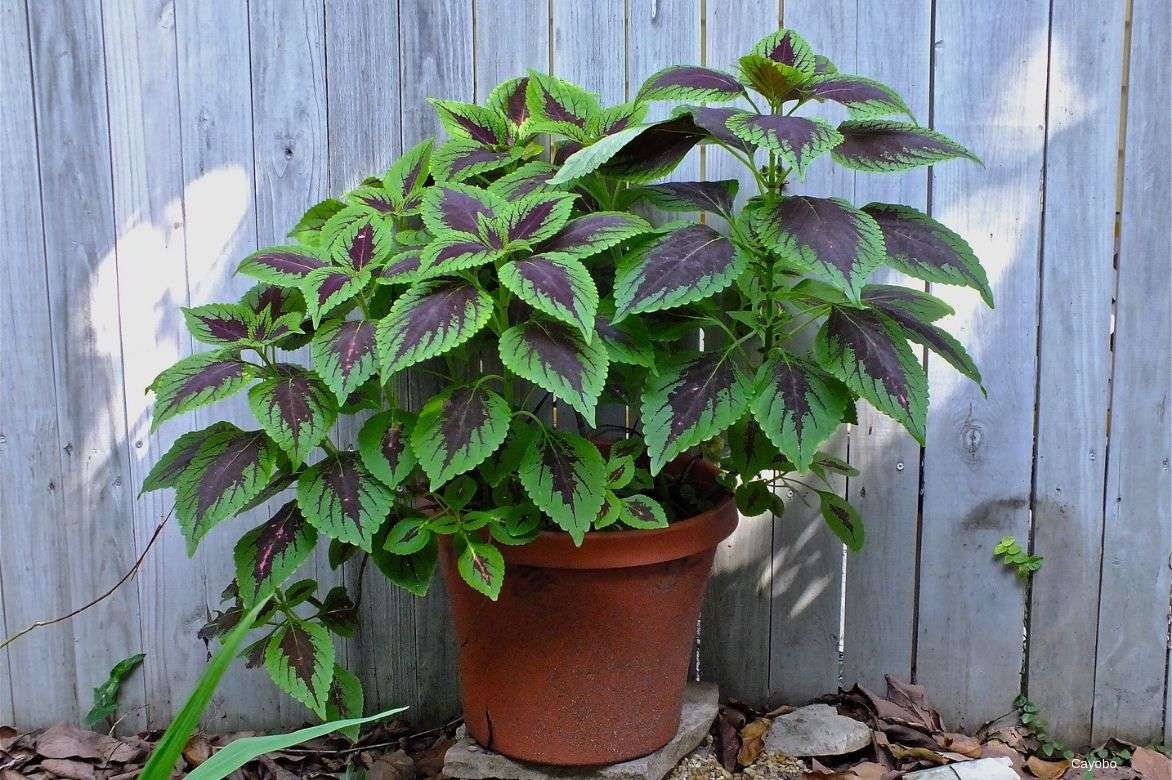
Caring for coleus
Le Coleus is one of those easy, undemanding annual plants provided soil remains cool and well drained in summer.
In pots or in ground, throughout whole growing season, Coleus needs regular waterings : water without waterlogging the soil so it never dries out completely.
For potted coleus, add liquid fertiliser to the watering every 15 days for flowering plants: do not leave standing water in saucers.
Regularly pinch back young plants (remove shoot tips with thumb and forefinger) to encourage their branching and keep clumps compact.
Remove flowers and flower buds as soon as they appear to prevent premature exhaustion of the plant and preserve lush, colourful foliage.
At end of autumn, pull up garden-grown coleus plants and store pots in a frost-free room or conservatory (10 °C) to bring them out again the following spring. During winter, keep in light and reduce waterings: rootball should dry out between waterings. Every year at start of spring, repot your coleus.
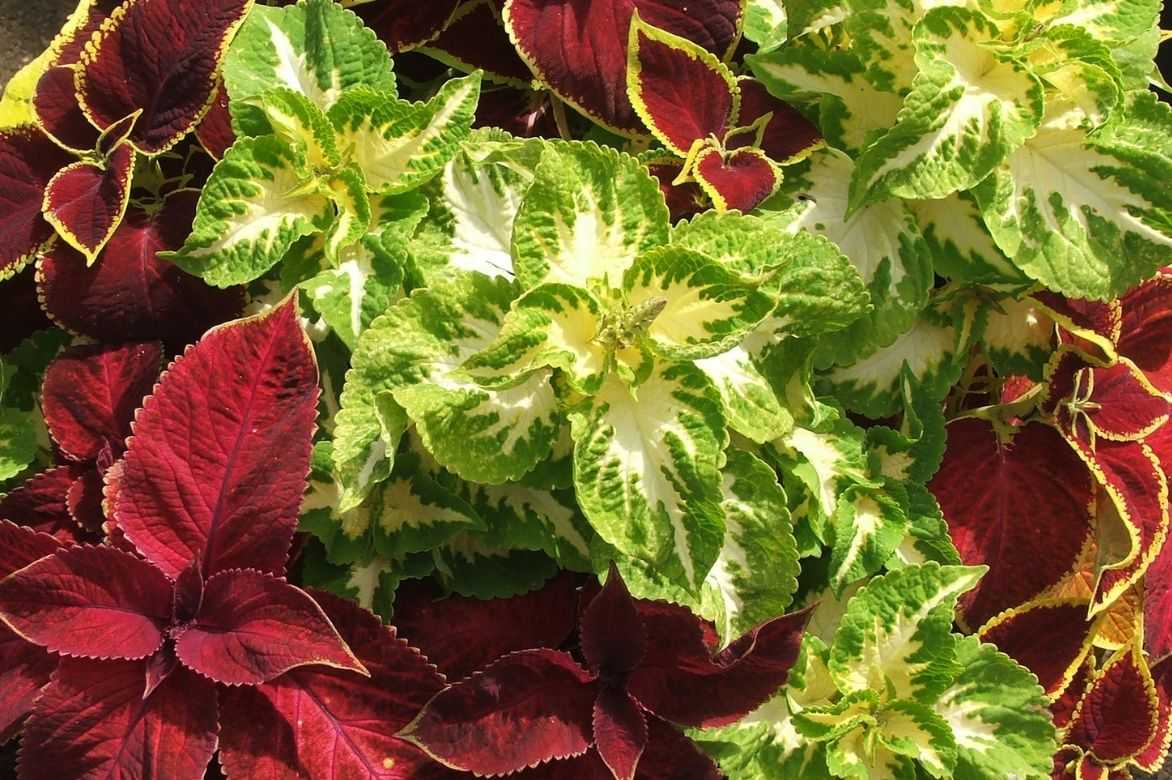
Potential diseases and pests
Coleus proves very resistant to diseases. It is vulnerable to slugs which adore its young foliage: follow our advice to combat their attacks!
If you notice the presence de aphids : spray water mixed with black soap or Marseille soap.
Coleus grown indoors are more vulnerable and are often prey to:
- mealybugs visible from the cottony, sticky residues they leave on foliage: remove them with a cotton pad soaked in 90° alcohol, then spray with rapeseed oil or a 5% black soap solution. Repeat regularly until they disappear.
- in a hot, overly dry atmosphere, red spider mites develop leaving spots on the foliage: immediately cut away heavily infested parts affected by these mites and spray lime-free water regularly on the foliage to keep a consistently humid atmosphere around the pot. Spray nettle macerations.
- whiteflies or greenhouse whiteflies are common on many indoor plants: they weaken Coleus in case of infestation: spray leaves with soapy water, optionally mixed with a little vegetable oil.
Find out more in our article: Coleus indoors: preventing and treating diseases and parasites.
Propagation: propagate coleus from cuttings
Coleus is a tender perennial worth keeping through propagation by cuttings in spring or summer. Sowing is also possible in spring in warm conditions, as you can read in our section “when and how to sow coleus seeds”.
How to take Coleus cuttings?
Cuttings are taken in spring or in June from stems not in bloom.
- Take stems 10 to 15 cm long
- Remove lower leaves and keep upper leaves
- Place these cuttings in a glass of water or in buckets filled with moist potting compost
- When roots develop after 2 to 3 weeks, pot on into 10 to 12 cm pots in a mixture of soil, potting compost and sand
- Keep frost-free in light at 15°C, watering regularly until next spring
- Pinch out young plants during winter
- Following spring, plant cuttings in open ground or in pots in May after frosts
Pairing coleus
Coleus is an indispensable plant in all colourful gardens, and even in shade gardens where its striking foliage brightens cooler spots. It is useful for creating colourful focal points, sumptuous velvety clumps and subtle textural combinations.

An idea for a container combination: Antirrhinum majus ‘Black Prince’, Begonia Summerwings ‘White Elegance’ and Coleus ‘Skyfire’
With its infinitely variable hues and fairly full habit, it adapts to every desire and can be used alone or in small groups. It creates beautiful scenes throughout the growing season without relying on flowers.
To produce a strong visual impact, contrast colours in small touches too. Cultivars with absinthe-green leaves marginate with cream will thrive at the feet of Dicentra spectabilis ‘Goldheart®’, a euphorbia, Geum ‘Eos’ or the acid foliage of heucheras ‘Lime Rickey’, in refreshing green gradations.
In red/black schemes, dark-leaved coleus varieties will sit well alongside plants with blackish-purple foliage such as some hardy geraniums, heucheras, a morning glory or lobelias.
For a graphic use, create a contrast between the opulent foliage of coleus and the long, sharp habit of phormiums, the tousled carex, and the dense, gracefully arched Uncinia rubra.

A planting idea for a border: Perovskia such as ‘Little Spire’, Stipa tenuifolia, Dahlia ‘Ivanetti’ and Coleus ‘Kingwood of Torch’ or a darker one such as ‘Black Prince’ would also suit very well
It will elegantly edge a lush summer border alongside a mix of annuals such as nigellas, cosmos, Linum grandiflorum ‘Rubrum’ or perennials flowering in summer such as delphiniums or lupins.
In a very colourful bed, pair it with the velvety flowers of Calibrachoa, Convolvulus sabatius, and ornamental sweet potato morning glories appreciated for their foliage, such as the ‘Sweet Caroline‘ collection.
In bold warm-toned compositions, it will sit alongside echinaceas, zinnias, an Amaranthus tricolour ‘Garden select’, a Fuchsia and tall cannas.
Dark varieties such as ‘Black Prince’ add whimsy to a black garden and a white garden, and pair in chic compositions with black flowers such as Iris ‘Black Knight’, black arum, Alcea rosea ‘Nigra’, white foxgloves, hardy geraniums with purple foliage or an Ophiopogon ‘Hosoba Kokuryu’, set against Arundo donax ‘Variegata Versicolor’ and Acorus gramineus ‘Variegatus’ in the background.
Its vivid personality also finds a place among ornamental grasses such as Pennisetum and Miscanthus, which it will enliven.
It brings a graphic foliage note to window boxes and hanging baskets combined with impatiens, begonias, ornamental tobaccos or diascias.
Its attractive warm-coloured leaves (Coleus ‘Rainbow’) harmonise with certain shrubs with coloured autumn foliage such as maples, barberries and deciduous euonymus.
Useful resources
- Coleus: to grow and care for it indoors.
- Discover our tutorial: how to sow coleus?
- Find our most beautiful annual plants in our nursery!
- Follow all our tips to plant annuals successfully
- Discover our collections of annual flower plug plants!
- Subscribe!
- Contents
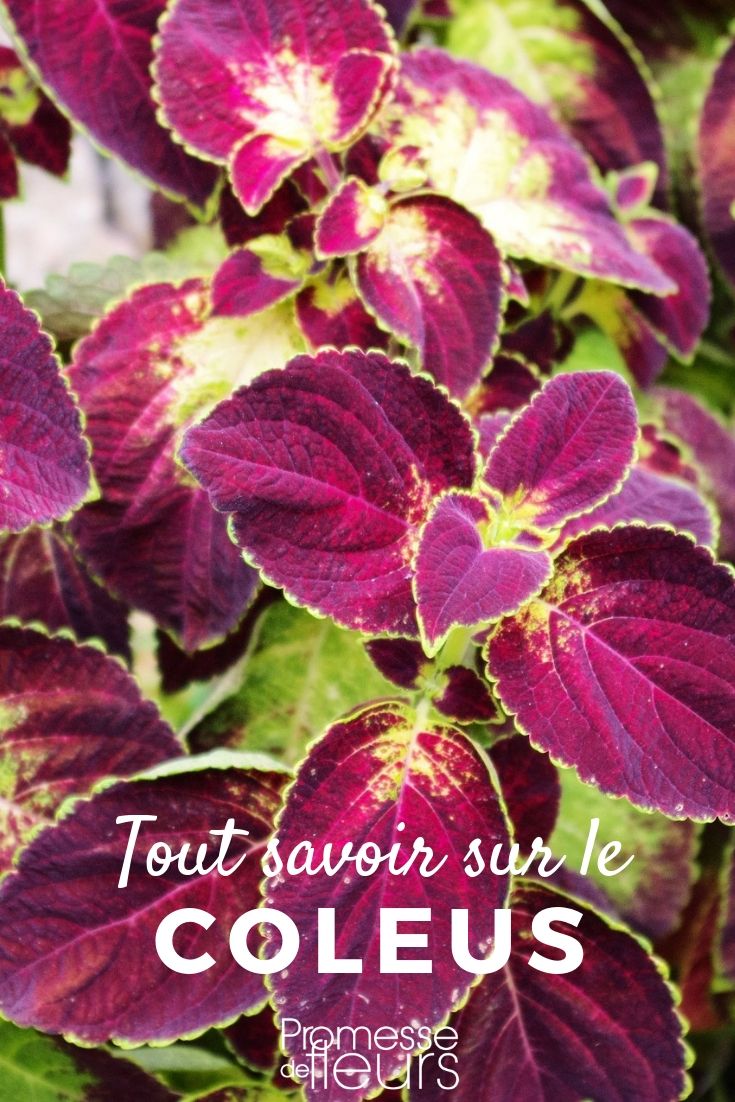






























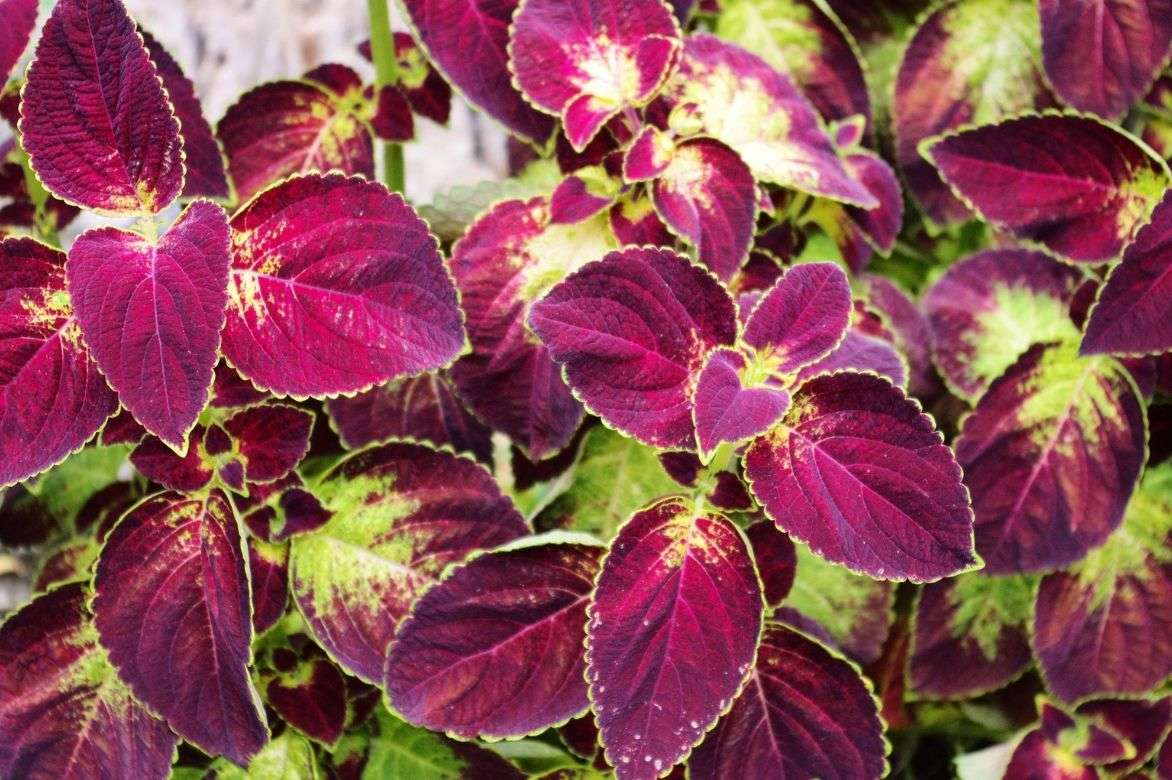

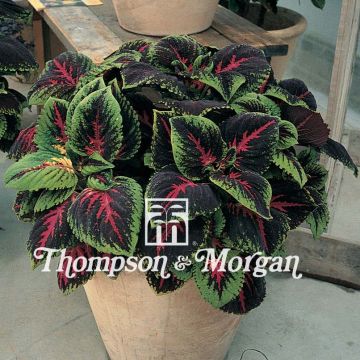


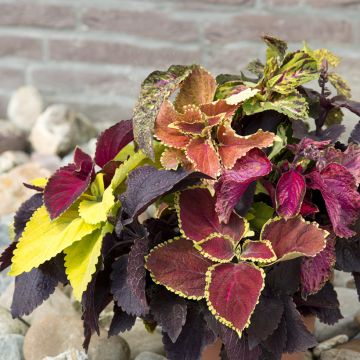
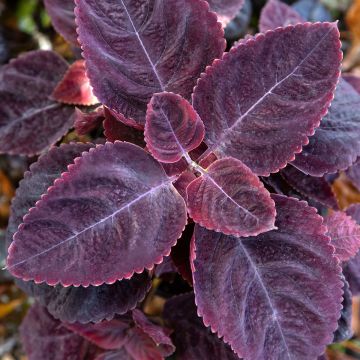
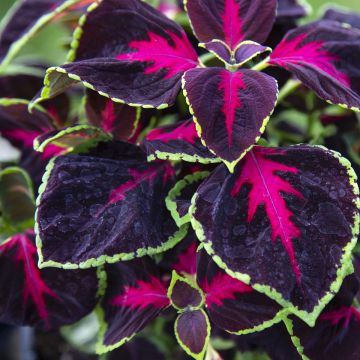


Comments